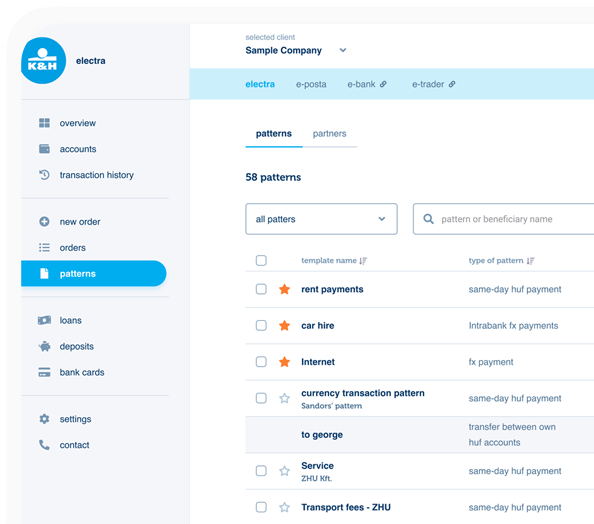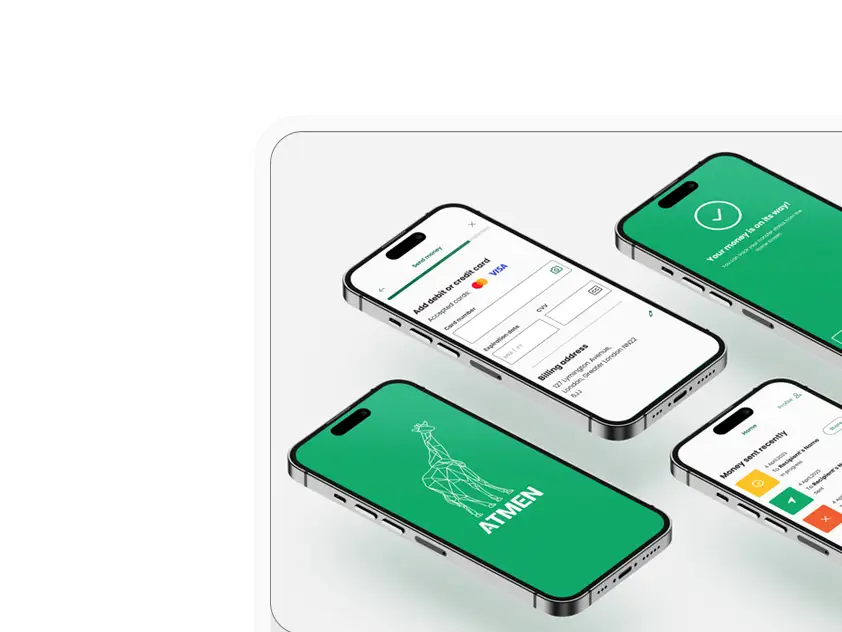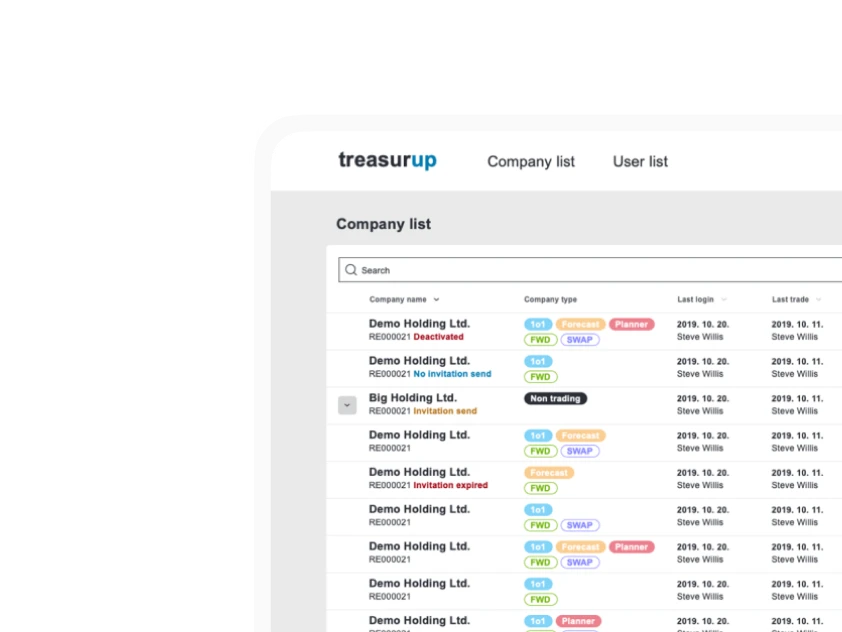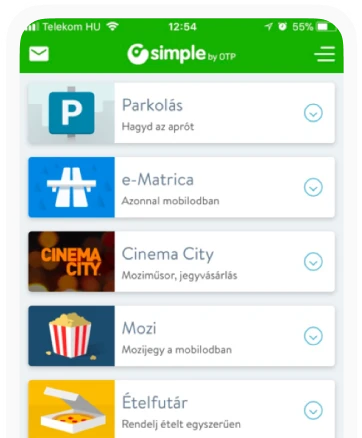Fintech UX for B2B
The Pont Vecchio, or Old Bridge, in Florence has nearly fifty shops across its span. Almost all of them are jewellers of one sort or another. Some sell gems, others watches, or gold and silver items. It’s great for shoppers to wander from one outlet to another, but how does it work for the businesses?
I’ve often thought of this paradox of how companies which are naturally competitors will band together in an association or guild to confront common issues, and promote their products. Not a lot has changed in that respect since the Renaissance in Florence.
But isn’t it somewhat counter-intuitive to organise events and invite the competition to also show their wares? Ergomania founder and CEO, Dr. András Rung, thinks otherwise. “Ergomania finds it critical to focus on business clients in the Fintech and banking space since we think they deserve and demand decent interfaces from the UX perspective. We think that after the Fintech revolution of Retail interfaces it is time to reform the SME and Corporate financial space too.” OK, point taken, but why not just leverage Ergomania’s already considerable skills in Fintech, and tough luck on other companies unable to keep up?
“In part it’s about critical mass,” answers Rung. “Twenty years ago UX-UI was nowhere near being an industry. Now it is, with millions of designers active across the world. We have to share best practices and anticipate trends, because if we don’t, we are not serving our clients in the way we should be.” So openness it is, which promotes trust, especially among the Banking and Fintech execs who comprise Ergomania’s target audience. Of course, if you’re going to set up your shop window right next to a rival, you have to be pretty confident in the quality of your offering. The participants in the Product Design Talks series bring deep experience to the events, along with stimulating views.
So what can be expected from an Ergomania Design Talk? Well the best way is to attend live online, so that questions can be raised during the event itself, but fortunately the series is also recorded, so let’s get a brief taster from a YouTube recording of Fintech UX for Business in January 2021.
With András Rung as host and moderator, the event kicked off with a joint presentation into a Design System created for TreasurUp by Rabobank. First on was Maria Amidi-Nouri, UX Architect and Partner at Ergomania, speaking from the supplier point of view. She was followed by Eward Bartlema, at the time UX Head for TreasurUp in the Netherlands, and together they painted a picture of the importance of a Design System, and the rapid benefits possible by developing and deploying it. One of the keywords which came from both sides of the equation was ‘Trust’, and the sense of mutuality was noticeable. Joint presentation by Edward and Maria
Joint presentation by Edward and Maria
TreasurUp started life as an in-house hedging app developed by four Rabobank employees as part of an in-house incubator program. Initially named ‘Easytrade’, over the years the app has been developed into a powerful white label Treasury offering for banks, and has scored significant client successes, most recently with the recruitment of the Nordea Banking Group and KBC, Belgium to the platform.
The rapid growth, and significant changes in Easytrade/TreasurUp resulted in what Eward described as ‘inconsistencies’. The joint project with Ergomania ironed all these out, and provided a firm base for TreasurUp by Rabobank to successfully proceed.
With the two presentations complete, András Rung then asked Eward to stay on as part of a discussion panel. He was joined by Martin Schachinger, MD and Co-Founder of Finnoconsult, headquartered in Austria and focusing on the creation of financial innovation prototypes. Another guest from the ‘supplier’ side was Glenn Stevens, UX Researcher and Service Designer, joining from Belgium. Glenn also works for Belfius Bank, and uflow in Antwerp, so he somewhat blurs the lines between what constitutes a supplier and a client.
The final two panelists were firmly on the client side of the UX equation. Balázs Benkovics is Director of Digital Channels and Architecture at K&H Bank in Hungary, while Gergely Tyukodi is Managing Director at OTP eBIZ, part of OTP Bank, also in Hungary. The panel discussion
The panel discussion
Having seen how TreasurUp by Rabobank had re-engineered itself to be more Business-to-Business oriented,were there any trends in B2B UX the panel felt were noteworthy? András pointed out that ten or fifteen years previously UX had been at the forefront of major projects, but did that still apply?
Gergely Tyukodi, kicked off the discussion by observing that trends were being set in the retail area, initiated originally by Big Tech - Google, Apple, Facebook, and so on - which changed the way people look at, and what they expect from an application. “Individuals are wanting the same services and quality as companies,” he added. “And Fintechs are already onto this. It’s a train you must board!” He also felt that currently UX for banks is ‘not that sharp’ because no-one is either willing, or able to see the whole picture. Corporate products are more complex and diverse, and Gergely also felt that people are less keen to devote time and skill to understanding complicated things, especially when they know that these can be done more simply. Fail to answer that need, Gergely stressed, and they’ll move on to one of your competitors. This idea that now everyone is a consumer was to surface several times during the discussion, and that Digital Transformation is no longer an ‘ivory towers’ pursuit.
From a perspective of moving into a segment of the larger corporates, Edward Bartlema described how he and his TreasurUp colleagues had met with around 400 corporates in the last few years, saying, “To our surprise a lot of companies actually do not work in a very professional way. Even some of the larger companies were still working with Excel sheets and still made a lot of errors in their day-to-day tasks.” He cited one institute where, “We were doing the math and discovering major critical errors... or maybe missed opportunities, to put it more mildly!” So in Eward’s experience, many Corporates are not used to UX, but even if they are very conservative, that doesn’t mean there is no market for it.
Glenn Stevens agreed with András Rung’s central premise that B2C UX experiences are driving expectations, citing a report by Kate Moran, Senior User Experience Specialist at the Nielsen Norman group, in which she stated that on average the return on investments and general improvements that UX brings to the table is shrinking.
Say what? Glenn amplified that, “This sounds bad, but it’s good because the smaller gains represent (in some cases) going from previously very bad to decent. However most of this evolution has been done in the B2C retail sphere, but now it has started in the B2B sphere as well.” So Glenn says he is optimistic about what this can bring because, “For a lot of companies today it's not that the focus on efficiency or productivity is new - they have been focused on that for many years, and making their workflows error-proof in finance and administration. But people have just been ‘factors of production’. As UX designers we bring human focus so that systems adapt to people, not the other way round.”
And if this strikes you as kinda obvious, note that what Glenn is pointing to is the real disconnect which can still persist between what UX-ers would like to achieve, and what their clients are willing to go for.
Seen from a Banking point of view, Balázs Benkovics of KBC Hungary, K&H Group, said that the trends and changes he witnessed had come, “In waves, which usually started from retail and then moved into the corporate business and corporate segments, and then converged.” Describing the bad old User Unfriendly days, he said, “I can still remember my first internet bank app being a windows based application that I had to download and exchange some codes with my bank. Then that became quite common in corporate banking. Now retail is moving towards mobile and though there is some adoption of mobile in corporates it’s not as major as in retail. Still, it’s better than two or three years ago.”
Balázs also pointed out that in Hungary he doesn’t see SMEs and corporates as being the same, but that trends will, “Always find their way to the top segment.” Convergence has also been sped up due to the Covid pandemic - an example being electronic document exchange, needed across the board by businesses of all sizes. “The pandemic has forced through digital innovation.”
Martin Schachinger of Finnoconsult saw the wave of innovation moving from retail customers to large, (and then larger) companies and he hoped to see good user experiences developing from that. “Changes are coming from small beginnings, but step by step they are getting larger.”
“There is a difference between individual people and companies,” Glenn Stevens pointed out. “And then there is a difference between companies too.” He felt that it was relatively easy to distinguish between the needs of an individual and those of a company, but said that the continuum of companies covered a very wide spectrum. The fact of dealing with both a ‘Mom and Pop’ bakery with just a few employees, right through to a multinational organization makes his work in B2B UX highly rewarding. So do you need the same piece of software for the bakery and the conglomerate? - Highly unlikely, and yet until very recently that’s been the way things often were.
Gergely Tyukodi, touched on these questions of scale and scope in describing his own activity in OTP eBIZ, as a small subsidiary company within OTP Bank, dealing with businesses and digital solutions for SMEs and corporates. With a big bank or organization it's difficult to push through all the necessary changes that are required to develop good solutions. “From the banking point of view it's like the mass market is retail, so if you want to make digitalization and innovation happen, you have to address the people out there in the mass market, because there you have more revenue. So you can assume that the people who are using these software solutions, doing the banking business and corporate side have already got used to it. So they educate you!” In Gergely’s opinion, it’s hard for UX Agencies to get into banks, and much better to tackle SMEs, then expand into banking once solutions are created. Or as Martin Schachinger said, “Step by step.”
Although innovation is always high on the agenda whenever people get together to talk UX, Glenn Stevens did point out that it’s sometimes the modus operandi which catches the business. He spoke about Mint, saying that their only real differentiator was in the experience layer above functionalities, “They didn’t have more features than other tools available at the time, they just did it better and it was a case study in the sense that it's not about a feature factory and doing more than another company can do. It's about the experience you provide, and they did this in a financial tool and they kept using this approach and conquered the world. Basically this was a lesson for many companies who followed in their tracks, like SAP.”
András reflected that this might be an example of where you weren’t selling to users, but selling to decision makers. - Big difference. “In B2C UX you have an app store, and things can go viral if you build something that's really good - things tend to get adopted at some point if they’re worthwhile. But that’s not so in B2B UX where you can build a tremendous tool but still be bogged down by procurement processes.”
While the pace of change was still seen as somewhat slow by most of the panellists, Edward Bartelma was more upbeat about new methodologies, such as machine learning, and use of the blockchain. New technologies would bring new possibilities, with ‘Open everything’: Banking, APIs and Ecosystems for connected software and solutions. “But,” he added, “It's going to take a while.”
So where are we right now with UX for B2B? Progress is being made, for sure, and the Covid pandemic has lent a sense of urgency to the need for new developments. There seems to be an organic growth of services which reflect the B2C sector, and over time these will increasingly permeate corporates and banking. One problem to be overcome is that in larger organizations it’s often difficult to get the whole picture, and so sometimes it’s more productive to tackle issues on a case-by-case basis, or at departmental level.
The panel at this particular Product Design Talks by Ergomania session were in general agreement that human-centric UX was the way forward and the concept that ‘we are all consumers’ would increasingly apply to corporate and large organization engagement. While there was a strong sense that this would mainly be achieved through a slow, step by step process, there was nevertheless an interest in new technologies that will impact B2B activities across the board. It’s not an ‘if’, but merely a ‘when’.
The meetup showed a sense of optimism, even as we go through difficult times, and it seemed that Ergomania’s intention of bridging between different countries and levels of engagement in UX-UI was once again proving successful.
In a brief report, getting the full flavor of a session is not possible. For that you have to attend, and interact, so look out for the next scheduled Product Design Talks by Ergomania, the most popular design-related meetup in Central Europe. And it’s not just the formal part of the meetings that is valuable - meeting, chatting and exchanging ideas and experiences at the end of each session with the panel and other attendees offers vital pan-European networking opportunities. Ergomania includes not only other UX designers and companies in its network, but also business leaders from Fintech and Banking, meaning that priceless opinions and information within the sectors is available to attendees.
Crossing the Pont Vecchio and merely gazing in the windows of the jewelry shops isn’t quite enough - sometimes you have to go inside and really examine the precious goods!
I’ve often thought of this paradox of how companies which are naturally competitors will band together in an association or guild to confront common issues, and promote their products. Not a lot has changed in that respect since the Renaissance in Florence.
Bridging Europe
Ergomania is a Budapest-based UX-UI Design Agency, specialising in the Fintech arena, and has been providing valuable content for some time with their online Product Design Talks by Ergomania series. It’s a Design related meetup format for mainly Central European UX-UI designers and business-leading clients, which promotes freely shared ideas, and the latest trends in Fintech and Banking UX-UI. So both rival companies and potential clients can ‘window shop’ as easily as the tourists who - until recently - strolled across the River Arno in Florence, searching for that unique item of jewelry.But isn’t it somewhat counter-intuitive to organise events and invite the competition to also show their wares? Ergomania founder and CEO, Dr. András Rung, thinks otherwise. “Ergomania finds it critical to focus on business clients in the Fintech and banking space since we think they deserve and demand decent interfaces from the UX perspective. We think that after the Fintech revolution of Retail interfaces it is time to reform the SME and Corporate financial space too.” OK, point taken, but why not just leverage Ergomania’s already considerable skills in Fintech, and tough luck on other companies unable to keep up?
“In part it’s about critical mass,” answers Rung. “Twenty years ago UX-UI was nowhere near being an industry. Now it is, with millions of designers active across the world. We have to share best practices and anticipate trends, because if we don’t, we are not serving our clients in the way we should be.” So openness it is, which promotes trust, especially among the Banking and Fintech execs who comprise Ergomania’s target audience. Of course, if you’re going to set up your shop window right next to a rival, you have to be pretty confident in the quality of your offering. The participants in the Product Design Talks series bring deep experience to the events, along with stimulating views.
Ergomania Design Talks - a case in point
So what can be expected from an Ergomania Design Talk? Well the best way is to attend live online, so that questions can be raised during the event itself, but fortunately the series is also recorded, so let’s get a brief taster from a YouTube recording of Fintech UX for Business in January 2021.
With András Rung as host and moderator, the event kicked off with a joint presentation into a Design System created for TreasurUp by Rabobank. First on was Maria Amidi-Nouri, UX Architect and Partner at Ergomania, speaking from the supplier point of view. She was followed by Eward Bartlema, at the time UX Head for TreasurUp in the Netherlands, and together they painted a picture of the importance of a Design System, and the rapid benefits possible by developing and deploying it. One of the keywords which came from both sides of the equation was ‘Trust’, and the sense of mutuality was noticeable.
 Joint presentation by Edward and Maria
Joint presentation by Edward and MariaTreasurUp started life as an in-house hedging app developed by four Rabobank employees as part of an in-house incubator program. Initially named ‘Easytrade’, over the years the app has been developed into a powerful white label Treasury offering for banks, and has scored significant client successes, most recently with the recruitment of the Nordea Banking Group and KBC, Belgium to the platform.
The rapid growth, and significant changes in Easytrade/TreasurUp resulted in what Eward described as ‘inconsistencies’. The joint project with Ergomania ironed all these out, and provided a firm base for TreasurUp by Rabobank to successfully proceed.
The panel discussion - an excerpt
With the two presentations complete, András Rung then asked Eward to stay on as part of a discussion panel. He was joined by Martin Schachinger, MD and Co-Founder of Finnoconsult, headquartered in Austria and focusing on the creation of financial innovation prototypes. Another guest from the ‘supplier’ side was Glenn Stevens, UX Researcher and Service Designer, joining from Belgium. Glenn also works for Belfius Bank, and uflow in Antwerp, so he somewhat blurs the lines between what constitutes a supplier and a client.
The final two panelists were firmly on the client side of the UX equation. Balázs Benkovics is Director of Digital Channels and Architecture at K&H Bank in Hungary, while Gergely Tyukodi is Managing Director at OTP eBIZ, part of OTP Bank, also in Hungary.
 The panel discussion
The panel discussionHaving seen how TreasurUp by Rabobank had re-engineered itself to be more Business-to-Business oriented,were there any trends in B2B UX the panel felt were noteworthy? András pointed out that ten or fifteen years previously UX had been at the forefront of major projects, but did that still apply?
Gergely Tyukodi, kicked off the discussion by observing that trends were being set in the retail area, initiated originally by Big Tech - Google, Apple, Facebook, and so on - which changed the way people look at, and what they expect from an application. “Individuals are wanting the same services and quality as companies,” he added. “And Fintechs are already onto this. It’s a train you must board!” He also felt that currently UX for banks is ‘not that sharp’ because no-one is either willing, or able to see the whole picture. Corporate products are more complex and diverse, and Gergely also felt that people are less keen to devote time and skill to understanding complicated things, especially when they know that these can be done more simply. Fail to answer that need, Gergely stressed, and they’ll move on to one of your competitors. This idea that now everyone is a consumer was to surface several times during the discussion, and that Digital Transformation is no longer an ‘ivory towers’ pursuit.
Doing the math!
From a perspective of moving into a segment of the larger corporates, Edward Bartlema described how he and his TreasurUp colleagues had met with around 400 corporates in the last few years, saying, “To our surprise a lot of companies actually do not work in a very professional way. Even some of the larger companies were still working with Excel sheets and still made a lot of errors in their day-to-day tasks.” He cited one institute where, “We were doing the math and discovering major critical errors... or maybe missed opportunities, to put it more mildly!” So in Eward’s experience, many Corporates are not used to UX, but even if they are very conservative, that doesn’t mean there is no market for it.
Glenn Stevens agreed with András Rung’s central premise that B2C UX experiences are driving expectations, citing a report by Kate Moran, Senior User Experience Specialist at the Nielsen Norman group, in which she stated that on average the return on investments and general improvements that UX brings to the table is shrinking.
Say what? Glenn amplified that, “This sounds bad, but it’s good because the smaller gains represent (in some cases) going from previously very bad to decent. However most of this evolution has been done in the B2C retail sphere, but now it has started in the B2B sphere as well.” So Glenn says he is optimistic about what this can bring because, “For a lot of companies today it's not that the focus on efficiency or productivity is new - they have been focused on that for many years, and making their workflows error-proof in finance and administration. But people have just been ‘factors of production’. As UX designers we bring human focus so that systems adapt to people, not the other way round.”
And if this strikes you as kinda obvious, note that what Glenn is pointing to is the real disconnect which can still persist between what UX-ers would like to achieve, and what their clients are willing to go for.
The wave effect
Seen from a Banking point of view, Balázs Benkovics of KBC Hungary, K&H Group, said that the trends and changes he witnessed had come, “In waves, which usually started from retail and then moved into the corporate business and corporate segments, and then converged.” Describing the bad old User Unfriendly days, he said, “I can still remember my first internet bank app being a windows based application that I had to download and exchange some codes with my bank. Then that became quite common in corporate banking. Now retail is moving towards mobile and though there is some adoption of mobile in corporates it’s not as major as in retail. Still, it’s better than two or three years ago.”
Balázs also pointed out that in Hungary he doesn’t see SMEs and corporates as being the same, but that trends will, “Always find their way to the top segment.” Convergence has also been sped up due to the Covid pandemic - an example being electronic document exchange, needed across the board by businesses of all sizes. “The pandemic has forced through digital innovation.”
Martin Schachinger of Finnoconsult saw the wave of innovation moving from retail customers to large, (and then larger) companies and he hoped to see good user experiences developing from that. “Changes are coming from small beginnings, but step by step they are getting larger.”
One size fits all?
“There is a difference between individual people and companies,” Glenn Stevens pointed out. “And then there is a difference between companies too.” He felt that it was relatively easy to distinguish between the needs of an individual and those of a company, but said that the continuum of companies covered a very wide spectrum. The fact of dealing with both a ‘Mom and Pop’ bakery with just a few employees, right through to a multinational organization makes his work in B2B UX highly rewarding. So do you need the same piece of software for the bakery and the conglomerate? - Highly unlikely, and yet until very recently that’s been the way things often were.
Gergely Tyukodi, touched on these questions of scale and scope in describing his own activity in OTP eBIZ, as a small subsidiary company within OTP Bank, dealing with businesses and digital solutions for SMEs and corporates. With a big bank or organization it's difficult to push through all the necessary changes that are required to develop good solutions. “From the banking point of view it's like the mass market is retail, so if you want to make digitalization and innovation happen, you have to address the people out there in the mass market, because there you have more revenue. So you can assume that the people who are using these software solutions, doing the banking business and corporate side have already got used to it. So they educate you!” In Gergely’s opinion, it’s hard for UX Agencies to get into banks, and much better to tackle SMEs, then expand into banking once solutions are created. Or as Martin Schachinger said, “Step by step.”
The differentiator isn’t always innovation
Although innovation is always high on the agenda whenever people get together to talk UX, Glenn Stevens did point out that it’s sometimes the modus operandi which catches the business. He spoke about Mint, saying that their only real differentiator was in the experience layer above functionalities, “They didn’t have more features than other tools available at the time, they just did it better and it was a case study in the sense that it's not about a feature factory and doing more than another company can do. It's about the experience you provide, and they did this in a financial tool and they kept using this approach and conquered the world. Basically this was a lesson for many companies who followed in their tracks, like SAP.”
András reflected that this might be an example of where you weren’t selling to users, but selling to decision makers. - Big difference. “In B2C UX you have an app store, and things can go viral if you build something that's really good - things tend to get adopted at some point if they’re worthwhile. But that’s not so in B2B UX where you can build a tremendous tool but still be bogged down by procurement processes.”
While the pace of change was still seen as somewhat slow by most of the panellists, Edward Bartelma was more upbeat about new methodologies, such as machine learning, and use of the blockchain. New technologies would bring new possibilities, with ‘Open everything’: Banking, APIs and Ecosystems for connected software and solutions. “But,” he added, “It's going to take a while.”
Where now, and where next?
So where are we right now with UX for B2B? Progress is being made, for sure, and the Covid pandemic has lent a sense of urgency to the need for new developments. There seems to be an organic growth of services which reflect the B2C sector, and over time these will increasingly permeate corporates and banking. One problem to be overcome is that in larger organizations it’s often difficult to get the whole picture, and so sometimes it’s more productive to tackle issues on a case-by-case basis, or at departmental level.
The panel at this particular Product Design Talks by Ergomania session were in general agreement that human-centric UX was the way forward and the concept that ‘we are all consumers’ would increasingly apply to corporate and large organization engagement. While there was a strong sense that this would mainly be achieved through a slow, step by step process, there was nevertheless an interest in new technologies that will impact B2B activities across the board. It’s not an ‘if’, but merely a ‘when’.
The meetup showed a sense of optimism, even as we go through difficult times, and it seemed that Ergomania’s intention of bridging between different countries and levels of engagement in UX-UI was once again proving successful.
Cross the bridge
In a brief report, getting the full flavor of a session is not possible. For that you have to attend, and interact, so look out for the next scheduled Product Design Talks by Ergomania, the most popular design-related meetup in Central Europe. And it’s not just the formal part of the meetings that is valuable - meeting, chatting and exchanging ideas and experiences at the end of each session with the panel and other attendees offers vital pan-European networking opportunities. Ergomania includes not only other UX designers and companies in its network, but also business leaders from Fintech and Banking, meaning that priceless opinions and information within the sectors is available to attendees.
Crossing the Pont Vecchio and merely gazing in the windows of the jewelry shops isn’t quite enough - sometimes you have to go inside and really examine the precious goods!






